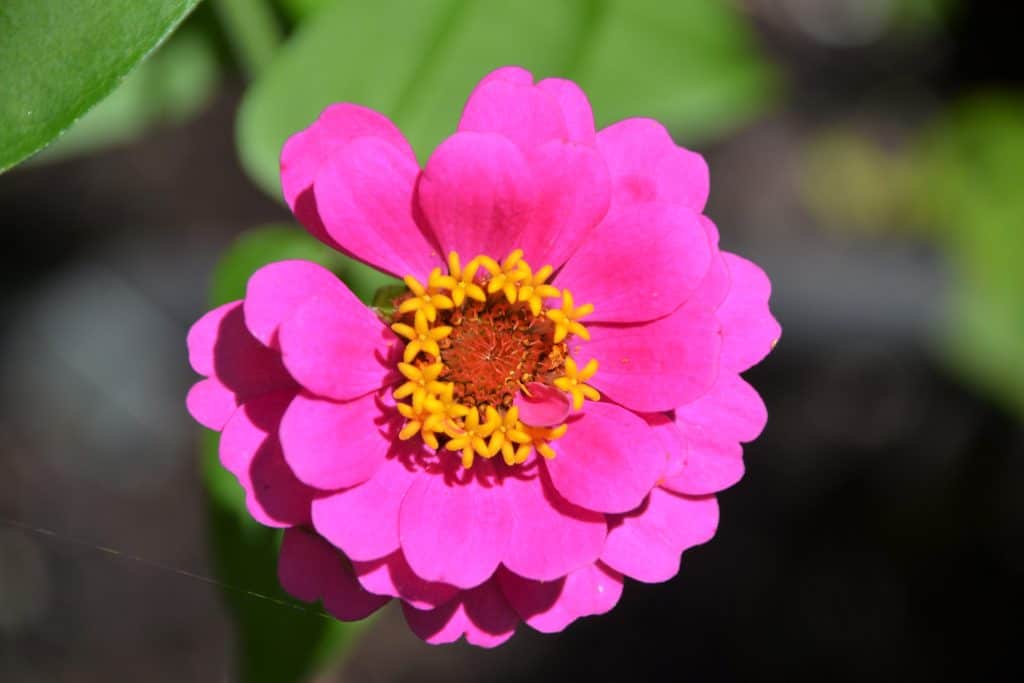Here’s what’s blooming in town this week to make your walks more enjoyable
By Laura Eisener
Happily, we got a clear view of the first of August’s full moons on Tuesday, with no smoke or clouds to hide it. Let’s hope for good weather again for the “blue moon” at the end of the month.
Many summer annuals are just now reaching their peak of bloom. The warm weather after all the rain brings faster growth and more blossoms.
Among the most popular annuals are zinnias. There are about 20 species in this genus from warm parts of North America and Central America. The earliest species introduced to Europe had small yellow flowers, but by the late 18th century a showier and more colorful species (Zinnia elegans) attracted the attention of gardeners. Hybrids have since resulted in even more shapes and color variations. Zinnias today have an incredible range of colors including vivid pink, red, orange, yellow, green, purple, and white. Some include more than one color. Like other members of the composite family (Asteraceae), such as sunflowers (Helianthus spp.), daisies (Leucanthemum spp.) and chrysanthemums (Chrysanthemum spp.). What most people refer to as a flower is a composite head of disk and ray florets. Single zinnias have one row of ray florets with petals around the outer edge of the head, and disk florets showing prominently in the center. Fully double zinnias have multiple rows of ray florets, and the disks are not visible. Semi-double zinnia types are in-between. Often the pistils of the disk florets have five-branched styles, which look like a yellow “flower within a flower.” Ray florets, though very showy with their colorful petals, are usually sterile, and only the disk florets have pistils and stamens. One of the features that endears zinnias to gardeners is the brightness of the colors compared to the “autumnal” shades of many chrysanthemums. Stems are usually 2′ tall or so but there are 3-4′ varieties, too. They can be fairly easily grown from seed planted outside in late May to bloom in late July, August and early September.
We are seeing the color pink a lot these days, partly due to the release of a certain movie about the doll with the pink mansion! The color pink got its name in the 17th century, named for a flower known as pink (Dianthus spp.) because of its petals with “pinked” edges, as though made with pinking shears. While the word “pink” can still be a verb associated with detailed punched or cut shapes, we are much more likely to think of it as a color, from very pale “petal pink” to deeper “shocking pink.” The color pink is also sometimes called rose in English and some other languages. In French it is “rose,” in Spanish, “rosa,” so whatever we choose to call “pale red” it is likely to be the name of a flower.
Hollyhocks (Alcea rosea) have been having a good year. If you look closely at the species name, it includes the word rose, although pink (or rose) is only one of the possible colors. One way or another, many Saugus gardens are “in the pink” this week.
Every summer I get a lot of questions about hydrangea flower color. Certain types of hydrangeas may be pink or blue depending on soil chemistry; in particular, if soil is more acidic the flowers tend to be blue, and if more alkaline, also sometimes called basic or sweet, the flowers will be pink. Bigleaf hydrangeas (Hydrangea macrophylla) and mountain hydrangea (Hydrangea serrata) are the only ones affected this way – other hydrangea species and most flowers in general do not have dramatic color changes based on soil acidity, also called soil pH. Since blue is an unusual flower color, people usually ask how to make their hydrangeas bluer, but occasionally they want a particular pink or purple color. Adding aluminum sulfate will increase blue, while adding limestone to soil increases pink tints. The deepest pink colors in hydrangea flowers, sometimes described as red, are found in varieties of mountain hydrangea like ‘Summer Crush’ or ‘Cherry Explosion.’ ‘Everlasting Harmony’ is a pale pink to greenish flowering variety of bigleaf hydrangea with “pinked” petal edges. There are also pink tints to the petals in some panicle hydrangeas (Hydrangea paniculata) like ‘Pinky Winky’ and ‘Quickfire,’ although soil pH does not affect the color in this case. Recent breeding efforts have resulted in pinkish tones in flowers of some smooth hydrangea varieties as well, such as ‘Invincibelle Spirit.’ Neither of these will ever have blue flowers, but may have white or pinkish blossoms.
Editor’s Note: Laura Eisener is a landscape design consultant who helps homeowners with landscape design, plant selection and placement of trees and shrubs, as well as perennials. She is a member of the Saugus Garden Club and offered to write a series of articles about “what’s blooming in town” shortly after the outbreak of the COVID-19 pandemic. She was inspired after seeing so many people taking up walking.
Catch all the Photo Highlights at: www.Facebook.com/Advocate.news.ma



